Related Research Articles

A shrine to the Virgin Mary, or Marian shrine, is a shrine marking an apparition or other miracle ascribed to the Blessed Virgin Mary, or a site on which is centered a historically strong Marian devotion. Such locales are often the destinations of Christian pilgrimages.

Our Lady of Peace, Mother of Peace, Queen of Peace or Our Lady Queen of Peace is a title of the Blessed Virgin Mary in the Roman Catholic Church. She is represented in art holding a dove and an olive branch, symbols of peace. Her official memorial in the General Roman Calendar is on July 9 in the universal Church except for Hawaii and some churches in the United States, where it is kept on January 24.
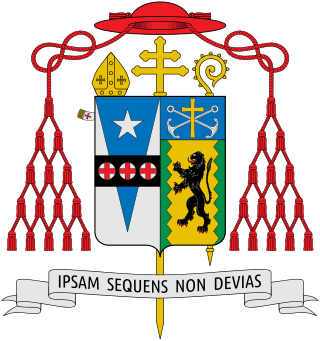
John Francis O'Hara was an American member of the Congregation of Holy Cross and prelate of the Catholic Church. He served as president of the University of Notre Dame (1934–1939) and as the Archbishop of Philadelphia from 1951 until his death, and was elevated to the cardinalate in 1958.

Our Lady of Sorrows, Our Lady of Dolours, the Sorrowful Mother or Mother of Sorrows, and Our Lady of Piety, Our Lady of the Seven Sorrows or Our Lady of the Seven Dolours are names by which Mary, mother of Jesus, is referred to in relation to sorrows in life. As Mater Dolorosa, it is also a key subject for Marian art in the Catholic Church.

Our Mother of Perpetual Succour is a title of the Mary, mother of Jesus in Catholicism associated with a 15th-century Byzantine icon and a reputed Marian apparition. The image has been enshrined in the Church of San Matteo in Via Merulana since 27 March 1499, and is today permanently enshrined in the Church of Saint Alphonsus of Liguori in Rome, where the novena to Our Mother of Perpetual Help is prayed weekly.

Marian hymns are Christian songs focused on Mary, mother of Jesus. They are used in both devotional and liturgical services, particularly by the Roman Catholic, Eastern Orthodox, Oriental Orthodox, Anglican, and Lutheran churches. They are often used in the month of May devotions. Some have also been adopted as Christmas hymns. Marian hymns are not popular among some Protestants, as they see Marian veneration as idolatry. However, the practice is very common among Christians of Catholic traditions, and a key component of the Eastern Orthodox liturgy. There are many more hymns to Mary within the Eastern Orthodox yearly cycle of liturgy than in Roman Catholic liturgy.
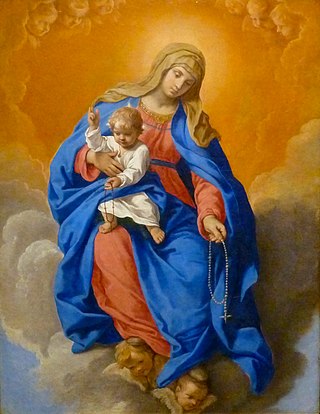
Our Lady of the Rosary, also known as Our Lady of the Holy Rosary, is a Marian title.
Our Lady often refers to:

Mary, the mother of Jesus in Christianity, is known by many different titles, epithets, invocations, and several names associated with places.

Located at 6, rue Notre-Dame-des-Victoires, in the 2nd arrondissement of Paris, The Basilica of Notre-Dame-des-Victoires is one of ten minor basilicas located in the Île-de-France region of France. It was begun as an Abbey church, and constructed between 1629 and 1740 in the French classical style. Its name was given by King Louis XIII, who dedicated it to his victory over the Protestants at La Rochelle in 1628 during the French Wars of Religion. Notre-Dame-des-Victoires is famous for the ex voto offerings left there by the faithful. Over 37,000 devotional plaques, silver and gold hearts, as well as military decorations, have been left at the basilica. The closest Métro station is 'Bourse'.

May devotions to the Blessed Virgin Mary refer to special Marian devotions held in the Catholic Church during the month of May honoring Mary, mother of God, as "the Queen of May". These services may take place inside or outside. A "May Crowning" is a traditional Roman Catholic ritual that occurs in the month of May.

The veneration of Mary in the Catholic Church encompasses various devotions which include prayer, pious acts, visual arts, poetry, and music devoted to her. Popes have encouraged it, while also taking steps to reform some manifestations of it. The Holy See has insisted on the importance of distinguishing "true from false devotion, and authentic doctrine from its deformations by excess or defect". There are significantly more titles, feasts, and venerative Marian practices among Roman Catholics than in other Western Christian traditions. The term hyperdulia indicates the special veneration due to Mary, greater than the ordinary dulia for other saints, but utterly unlike the latria due only to God.
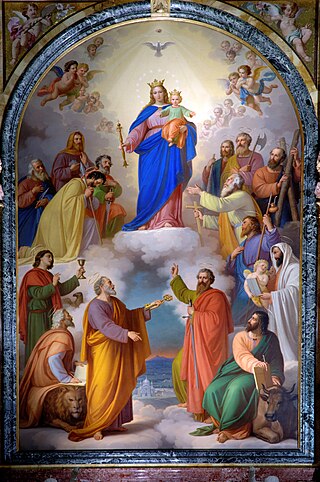
Mary, the Help of Christians, is a Roman Catholic title of the Blessed Virgin Mary, based on a religious devotion now associated with a feast day of the General Roman Calendar on 24 May.

Refugium Peccatorum meaning Refuge of Sinners is a Catholic title for the Blessed Virgin Mary. Its use goes back to Saint Germanus of Constantinople in the 8th century.

The Virgin of Mercy is a subject in Christian art, showing a group of people sheltering for protection under the outspread cloak, or pallium, of the Virgin Mary. It was especially popular in Italy from the 13th to 16th centuries, often as a specialised form of votive portrait; it is also found in other countries and later art, especially Spain and Latin America.

The Oktavor Muttergottesoktav is a religious double-octave celebrated in honour of the Blessed Virgin Mary as one of the oldest and major annual religious celebrations of the Grand-Duchy of Luxembourg. It starts on the 3rd Sunday after Easter and closes with the Octave Procession on the 5th Sunday after Easter during the Month of Mary. It honours Our Lady of Luxembourg, Maria Mutter Jesu, Consolatrix Afflictorum, Patrona Civitatis et Patriae Luxemburgensis.
St. Mary's Academy of Kidapawan (SMA-Kidapawan), formerly Notre Dame of Kidapawan for Girls, is a Catholic educational institution operated by the Religious of the Virgin Mary (R.V.M.) located at the foot of Mt. Apo in Kidapawan City, North Cotabato, on the island of Mindanao in the Philippines.
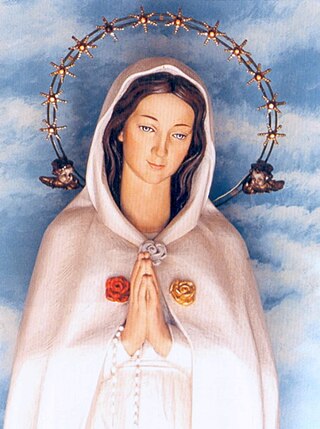
Rosa Mystica is a poetic title of Mary. One form of Marian devotion is invoking Virgin Mary's prayers by calling upon her using a litany of diverse titles, and the title 'Mystical Rose' is found in the Litany of Loreto. It is also a Catholic title of Our Lady based on the Marian apparitions reported between 1947 and 1966 by Pierina Gilli at Montichiari and Fontanelle, in Italy.
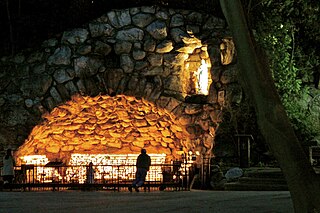
The Grotto of Our Lady of Lourdes is located at the University of Notre Dame in Notre Dame, Indiana, United States, and is a reproduction of the Grotto of Our Lady of Lourdes in Lourdes, France. The current Grotto was built in 1896, replacing a wooden grotto built on August 22, 1878. An artificial rock cave, the Grotto is used by its visitors as a sacred space for prayer, meditation, and outdoor Mass.

Notre-Dame-des-Champs is a Roman Catholic church located at 91 Boulevard du Montparnasse, at the southern edge of the 6th arrondissement of Paris. The church is named after the Blessed Virgin Mary, under the title of Our Lady of the Fields. It was completed in 1876, built using an iron framework designed by Gustave Eiffel.
